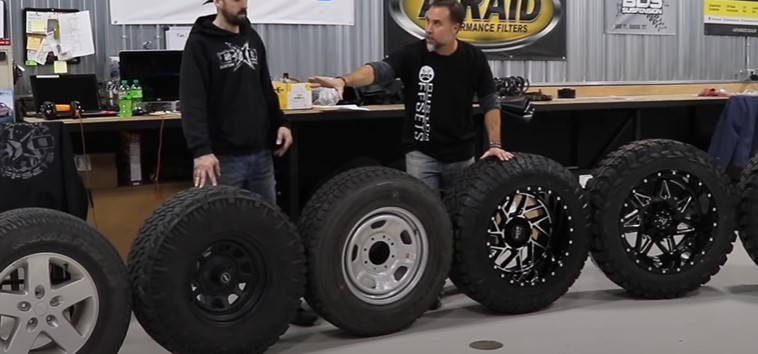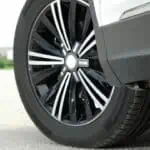Are you looking for What Tires Will Fit on a 16 Inch Rim? Yes, there are a few things to consider when purchasing tires for a 16 inch rim. The first is the width of the tire. The second is the aspect ratio, which is the height of the sidewall. And finally, the load index and speed rating must be considered.
The width of the tire is important because it needs to match up with the width of the rim. If the tire is too narrow, it will not fill out the wheel well and could result in instability. If the tire is too wide, it could rub on suspension components or bodywork. The ideal range for a 16 inch rim is 195mm-225mm.
The aspect ratio is important because it affects both comfort and handling. A taller sidewall will usually provide a smoother ride, but may sacrifice some handling ability. A shorter sidewall will improve handling but may make for a harsher ride quality.
Moreover, there are a few different options when it comes to tires that will fit on a 16 inch rim. Some of the most popular choices include all-season tires, summer tires, and winter tires. All-season tires are a great option if you want to be able to use your car all year round.
Summer tires are perfect for those who live in warmer climates and want to get the most out of their car during the summer months. Winter tires are ideal for those who live in colder climates and need extra traction during the winter months.
Finally, if you’re looking for the absolute best performance from your 16 inch rims, you may want to consider running racing slicks. These tires are made from softer compounds that provide better grip and traction on race tracks. However, they will wear down much faster than other types of tires so they’re not ideal for everyday driving.
Can You Put 35 Tires on 16 Rims?
Most people believe that you can only put 35 tires on 16 rims, but this is not true! You can actually put up to 38 tires on 16 rims. The reason most people believe that you can only put 35 tires on 16 rims is because of the way that the numbers are written out.
When you see “35”, you automatically think that it means 3.5 inches, which is the width of most tires. However, the number 35 actually refers to the diameter of the tire in millimeters. So, when you see “35”, it means that the tire has a diameter of 35mm.
Now that we’ve cleared that up, let’s get into how to properly measure your tires and rims so that you can make sure they will fit together perfectly. To start, you will need a tape measure and a calculator. First, use your tape measure to find out the circumference of your wheel.
To do this, simply wrap the tape measure around the middle of your wheel and then multiply this number by 2 (this will give you the diameter). Once you have your wheel’s diameter, divide it by 25.4 (this is because there are 25.4mm in an inch). This final number is what we refer to as your “inch measurement”
For example: If my wheel has a circumference of 60in then: 60in x 2 = 120in
120in / 25.4 = 4.724409449 in This would be considered a 4-inch wide wheel with a 15-inch diameter Now that we know how to properly measure our wheels and tires, let’s get into finding out if 35 tires will fit onto 16 rims without any issues!
As long as your tire has a width of 3-inches or less and an inch measurement (diameter) of 15 or less, then it should fit onto a 16-inch rim without any problems whatsoever!

Can a 15 Inch Tire Fit on a 16 Inch Rim?
The short answer is yes, a 15 inch tire can fit on a 16 inch rim. However, there are a few things to consider before making this switch.
For starters, different vehicles have different wheel sizes.
So it’s important to know the wheel size of your vehicle before making any changes. If you’re unsure, you can always consult your owner’s manual or take a look at the tires that are currently on your vehicle. The size will be listed on the sidewall of the tire.
Another thing to keep in mind is that changing tire sizes can affect your speedometer and odometer readings. A larger tire will result in higher readings, while a smaller tire will result in lower readings. This is because larger tires cover more ground per revolution than smaller tires do.
Finally, you’ll need to make sure that there’s enough clearance between the new tires and any brake calipers or suspension components. If there isn’t enough clearance, you could end up damaging those components when driving.
Overall, it’s perfectly fine to put 15 inch tires on 16 inch rims.
Just be sure to do your research beforehand and make sure that everything will fit properly!
Read Also: What Size Tires are 33S on 18 Inch Rims?Biggest Tire for 16 Inch Rim
There are a few things to consider when selecting the biggest tire for a 16 inch rim. The first is the width of the tire. A wider tire will provide more contact with the road, resulting in better traction. The second is the aspect ratio, which is the height of the tire’s sidewall compared to its width.
A taller sidewall will result in a smoother ride, but may sacrifice some handling. The third is the type of tread on the tire. Some tires are designed for off-road use and have deeper tread patterns, while others are designed for on-road use and have shallower tread patterns.
The biggest tire that can be safely used on a 16 inch rim is typically between 225 and 235 millimeters wide. For an off-road tire, an aspect ratio of 35 or 40 would be appropriate.
Moreover, its depend on the type of vehicle you will be driving. A car or truck with a smaller engine can usually handle a bigger tire than one with a larger engine. The second is the terrain you’ll be driving on.
If you’ll be driving mostly on highways, you can get away with a bigger tire than if you’ll be doing a lot of off-roading. The third is your personal preference.
Some people like the look of bigger tires, even if they don’t necessarily need them for performance. Ultimately, it’s up to you to decide what size tire will work best for your 16 inch rim.
Finally, you’ll want to think about the tread pattern of the tire. Tires with deeper tread patterns can grip the road better in wet or icy conditions, but they may not perform as well on dry roads. Now that you know a few things to keep in mind when choosing tires, let’s take a look at some of the best options for 16 inch rims.
For all-season performance, we recommend the Goodyear Assurance Triple Tread All-Season tire. This tire has a wide tread width for improved traction and handling, and its triple tread design provides excellent grip in all weather conditions.
If you live in an area with mostly dry roads, then you might prefer something like the Michelin Pilot Sport A/S 3+ All-Season tire.
This tire has a narrower width for increased speed and agility, and its unique tread pattern helps it cling to dry pavement even at high speeds. And finally, if you need maximum traction in winter weather conditions, then consider the Nokian Hakkapeliitta R2 SUV Winter Tire.

Which Tires Fit on Which Rims?
There are a few things to consider when determining which tires fit on which rims. First, you need to know the size of the tire. The size is usually printed on the side of the tire.
Second, you need to know the width of the rim. The width is usually printed on the side of the rim. Finally, you need to know the bolt pattern of the rim.
The bolt pattern is usually printed on the side of the rim. Tires and rims come in a variety of sizes. There are four main types of tires: passenger car tires, light truck tires, medium truck tires, and heavy duty truck tires.
Passenger car tires range in size from 13 inches to 19 inches. Light truck tires range in size from 20 inches to 29 inches. Medium truck tires range in size from 30 inches to 39 inches.
Heavy duty truck tires range in size from 40 inches to 49 inches. The width of a tire is measured in millimeters (mm). The width of a rim is also measured in millimeters (mm).
The width of a tire must be equal to or greater than the width of a rim. For example, if a tire has a width of 185 mm, it can be mounted on a rim with a width ranging from 185 mm to 195 mm inclusive. If a tire has a width of 225 mm, it can only be mounted on rims with a width of 225 mm or wider; it cannot be mounted on any narrower rims .
The bolt pattern of a rim is the number of bolts used to secure the tire to the rim and is typically expressed in an x/y format, where x equals the number of the sides and y equals the number of the turns needed to make one complete circle around the bolt circle.
For example, a 5×5 bolt pattern equals five bolts on sides spaced evenly around a circle with a diameter of two turns or inches .Most cars have four- or five-lug wheels while most trucks use six-or eight-lug wheels .
Read Also: Can You Put R16 Tires on R17 Rims?Biggest All-Terrain Tire for 16 Inch Rim
If you’re looking for the biggest all-terrain tire for a 16 inch rim, you’ll want to consider the BFGoodrich All-Terrain T/A KO2.
This tire is designed for both on and off-road use, and it features an aggressive tread pattern that provides excellent traction in all conditions. The KO2 also has a reinforced sidewall that helps to protect against punctures and other damage.
33 Inch Tires on 16 Inch Rims
If you’re looking to make a change to your vehicle’s appearance and performance, you may be considering swapping out your tires and rims. A popular choice among car enthusiasts is to put 33 inch tires on 16 inch rims. This combination can give your car a more aggressive look while also providing better handling and traction.
There are a few things to keep in mind if you’re planning on making this change to your car. First, you’ll need to make sure that your suspension is able to handle the larger tires. You may need to make some modifications or upgrades in order to avoid problems down the road.
Additionally, you’ll want to pay attention to the width of the tires when choosing your rims. Wider tires will require wider rims, so be sure to take that into account when making your selection.
Overall, putting 33 inch tires on 16 inch rims can be a great way to improve the appearance and performance of your car.
Just be sure to do your research beforehand and make any necessary changes or upgrades to ensure that everything will work together properly.
Can You Put a 16 Inch Tire on a 15 Inch Rim
Yes, when it comes to tires and rims, there are a lot of numbers involved. So, if you’re wondering if you can put a 16 inch tire on a 15 inch rim, the answer is…maybe.
It all depends on the specific tire and rim in question, as well as your vehicle. First things first, let’s talk about tires. A tire’s width is measured in millimeters (mm), and is listed on the sidewall of the tire.
For example, a 225/50R16 tire has a width of 225 mm. The “R” in this size indicates that it’s a radial tire, while the 16 signifies the diameter of the wheel that it will fit on – in this case, 16 inches. Now onto rims.
The width of a rim is also measured in millimeters (mm), and is usually between 4-8 inches wide. Just like with tires, the width is listed on the sidewall of the rim. For example, a 15×6 inch rim has a width of 15 inches.
So what does all this mean for putting a 16 inch tire on a 15 inch rim? Well, it’s possible – but not always recommended. If you do decide to go ahead with this combination, just be aware that changing either dimension by even 1 inch can throw off your vehicle’s speedometer readings and cause premature wear on your tires or wheels.
As always, consult with your trusted mechanic or dealership before making any changes to your vehicle to ensure safety and optimal performance!
Most Common 16 Inch Tire Sizes
There are a few different ways that you can measure the size of a tire, but one of the most common is by its diameter. The diameter is simply the distance from one side of the tire to the other. A 16 inch tire would have a diameter of 16 inches.
One reason that people might choose a 16 inch tire is because it is a good middle ground between 14 and 18 inch tires. It provides good handling and stability without being too big or too small. Plus, there are more choices when it comes to 16 inch tires than there are for either 14 or 18 inch tires.
You can find all sorts of different treads, brands, and prices when shopping for 16 inch tires.
If you’re not sure what size tire you need, consult your vehicle’s owner’s manual or ask a professional at your local auto shop. They will be able to help you figure out which size will work best for your car or truck.
Read Also: What Tires Fit 17X9 Rims? In-Depth InfoBiggest Tire for 16X7 Rim
There are a few things to consider when selecting the biggest tire for your 16×7 rim. First, you need to know the width of your wheel in order to determine the maximum width tire that will fit.
The next thing to consider is the diameter of the tire, as this will impact both the height and circumference of the tire.
Finally, you’ll want to make sure that the sidewall of the tire is not too tall for your wheel well. The biggest factor in determining what size tire you can put on your 16×7 rim is going to be the width of your wheel. A standard 16×7 wheel has a width of 6 inches, so you’ll want to look for a tire with a maximum width of about 9 inches.
Anything wider than that and you risk having the tire rub against your fender when turning or going over bumps. When it comes to diameter, you’ll want to stay around 27 inches or less. This will ensure that the height and circumference of the tire are not too large for your vehicle.
Additionally, taller sidewalls can make handling less precise, so it’s best to stick with shorter sidewalls if possible.
Putting all of this together, some good choices for tires that would work well on a 16×7 rim would be P215/60R16 or P225/50R16 tires. These are both fairly popular sizes that should provide a good balance between performance and comfort without being too big or small for your car.
Conclusion
There are a few things to consider when choosing tires for a 16 inch rim. The first is the width of the tire. A narrower tire will fit on a 16 inch rim, but it may not provide as much traction or be as durable as a wider tire.
The second thing to consider is the tread pattern of the tire. A tire with a more aggressive tread pattern may not be as stable on dry pavement as a tire with a less aggressive tread pattern. Finally, consider the type of terrain you’ll be driving on.
If you’ll be mostly driving on paved roads, you can get away with a less rugged tire than if you’re planning to do some off-road driving.










